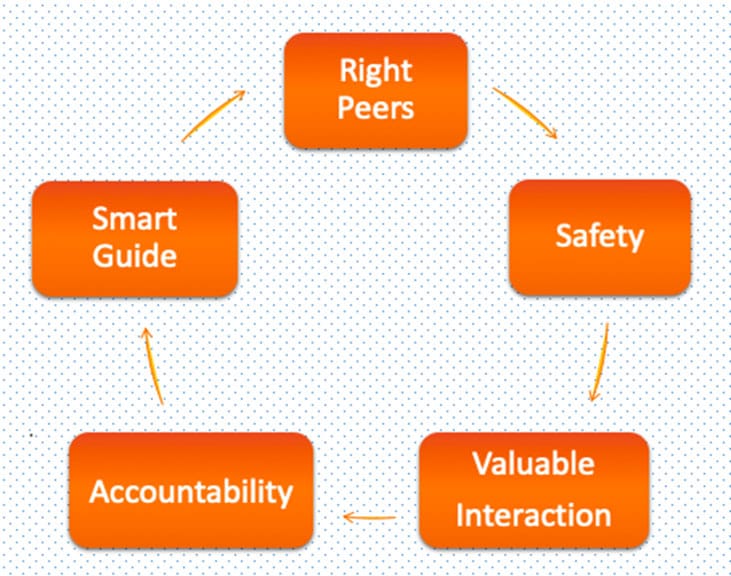Great Teams, Psychological Safety And The CEO

In today’s world, it’s hard to imagine a more important skill for CEOs than the ability to create and develop high performing teams in their organizations. I’m sure this fact contributed greatly to Google undertaking Project Aristotle, an in-depth study designed to identify the ingredients for effective teams – so named as a nod to the philosopher’s famous quote, “the whole is greater than the sum of its parts.” While we all realize that great teams can accomplish more than any individual member, we also understand that you just can’t throw a bunch of people in a room and hope for the best.
According to Google’s work on teams and research from The Power of Peers (2016) on groups, neither high performing teams nor groups were necessarily comprised of the most talented individual members. The best teams/groups were those whose members collaborated most effectively. It’s for this reason that the conditions necessary for such collaboration provide the best explanation for how Aristotle’s mathematical formula is even possible.
Great Teams
In order of importance, the five elements necessary for great teams are as follows:
- Psychological safety: Psychological safety refers to an individual’s perception of the consequences of taking an interpersonal risk or a belief that a team is safe for risk taking in the face of being seen as ignorant, incompetent, negative, or disruptive. In a team with high psychological safety, teammates feel safe to take risks around their team members. They feel confident that no one on the team will embarrass or punish anyone else for admitting a mistake, asking a question, or offering a new idea.
- Dependability: On dependable teams, members reliably complete quality work on time (vs the opposite – shirking responsibilities).
- Structure and clarity: An individual’s understanding of job expectations, the process for fulfilling these expectations, and the consequences of one’s performance are important for team effectiveness. Goals can be set at the individual or group level, and must be specific, challenging, and attainable. Google often uses Objectives and Key Results (OKRs) to help set and communicate short and long term goals.
- Meaning: Finding a sense of purpose in either the work itself or the output is important for team effectiveness. The meaning of work is personal and can vary: financial security, supporting family, helping the team succeed, or self-expression for each individual, for example.
- Impact: The results of one’s work, the subjective judgement that your work is making a difference, is important for teams. Seeing that one’s work is contributing to the organization’s goals can help reveal impact.
High Performing Groups
Expressed as a reinforcing loop, the five factors common to **high performing peer groups essentially aligns with Google’s findings:
Right Peers – This is defined not in terms of individual talent so much as shared purpose, diversity of perspective, and a common set of values for what drives effective collaboration among its members.
Safety – The core of a safe environment is psychological safety, regarded by group members as the ability to be open and vulnerable in a setting where confidentiality is sacrosanct. Simply stated: what happens in the group meeting, stays there.
Valuable Interaction – The safe environment speaks to psychological safety, while valuable interaction refers to intellectual engagement and group efficacy. As Google found as well, psychological safety is essential, but certainly not the only factor. Efficacy and tangible results matter.
Accountability – This speaks to accountability among members. A member’s personal currency among their peers involves being dependable about bringing their A game to each and every meeting. They in turn depend on their fellow members to do the same.
Smart Guide – Whether a group is led by a member or a professional facilitator, maximizing the potential of any group depends on having a leader who embraces a servant leader mentality and provides guidance and stewardship of the other four factors.

** The Power of Peers (2016)
The conclusion of both studies is clear: Without psychological safety, neither a team nor a group will perform to its potential. For clarity, Google provides a distinction between groups and teams that is different from the context of this comparison. For the purpose if this article, a team works together to achieve a collective goal or work product, while a group meets to advance the abilities and goals of its individual members.
What Does This Mean for CEOs?
Don’t confuse having an environment that is psychologically safe with having an environment where your employees are actually leveraging it to their personal and organizational advantage. The former along won’t get the job done. Pretend for a moment that you just built a spa that has an incredible pool that while it may be quite inviting, you notice nobody is using it. As an employee, this pool you built may call out my name, but instead of immersing myself in it to experience all its magic, I’m content to sit on a nearby lounge chair or simply dangle my toes in the water. The difference between having an environment where people feel comfortable being vulnerable and making mistakes, and people actually being vulnerable and taking actual risk is night and day. From the workshops I’ve been leading over the past two years across the US, Europe and Canada, I’ve found three factors that will help people actually use the psychologically safe environment you’ve worked so hard to create.
- Familiarity – the better your employees know one another, both as fellow professionals and, even more importantly, as human beings, the more likely they will be comfortable taking risks together. Encourage your employees to really get to know one another.
- The first person who is brave enough to admit they don’t know something or take a real risk will serve as an important model for others. This act of generosity and courage will benefit all involved. If you have a team member who is more inclined to be vulnerable, ask for their leadership. The power of peers is real.
- When it comes to modeling behavior, the first person to share is critical, but the behavior of the team members as empathetic and attentive listeners is equally important. These people serve as the water in the spa pool. Make sure it’s as soothing and warm as advertised.
Yes, the whole IS greater than the sum of its parts. It’s also true that birds of a feather flock together, we’re all in the same boat, and great minds think alike. The CEOs who understand this best will have the greatest chance to create and develop high performing teams.
Written by Leo Bottary. Have you read?
# Four simple ways leaders can make the workplace less stressful for their team by Dr. Amantha Imber.
# Revealed: These Are The Best US States To Live In, 2019.
# Which New York Colleges And Universities Are Ranked In The Top 100 Nationally For Best Value?
# America’s Top 100 Best Value Colleges And Universities For 2019.
# What Are You Doing To Help Your Team Succeed by John Akhoian.
Bring the best of the CEOWORLD magazine's global journalism to audiences in the United States and around the world. - Add CEOWORLD magazine to your Google News feed.
Follow CEOWORLD magazine headlines on: Google News, LinkedIn, Twitter, and Facebook.
Copyright 2025 The CEOWORLD magazine. All rights reserved. This material (and any extract from it) must not be copied, redistributed or placed on any website, without CEOWORLD magazine' prior written consent. For media queries, please contact: info@ceoworld.biz








